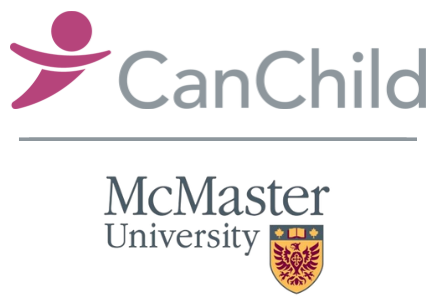In Brief © Pranay Jindal, Joy MacDermid, Peter Rosenbaum, Mary Law, 2011
This summary is written to help families of children with Cerebral Palsy to understand the findings of a research study “Focus on function: a cluster, randomized controlled trial comparing child-versus context focused intervention for young children with cerebral palsy” [click here to read the study].
Important findings
- Therapy that focuses on changing the activity and the environment is as effective in improving functioning as therapy focusing on changing the child.
- Both therapies improve the child’s self-care activities, mobility, general skills, and play activities.
What is Cerebral Palsy?
Cerebral Palsy is a disorder in the development of movement and posture. Children with cerebral palsy have movement challenges and may also have limitations in the areas of communication and behaviour. Due to these challenges, a child with Cerebral Palsy may have difficulty performing day-to-day activities. Click on the following links to know more about Cerebral Palsy. [1, 2, 3, 4, 5, 6]
Why the study was done?
Traditionally, treatments for children with Cerebral Palsy have focused on changing their function by trying to change movement limitations such as muscle weakness, limited joint range of motion, poor balance and coordination. This type of intervention approach focused on changing the child is known Child focused therapy. Click on the following links to know more on child focused therapies [7, 8]. A different approach is to focus on changing the activity or the environment to allow children to take part in their desired activities in whatever ways they can. This is known as Context focused therapy. [Click here to know more about context focused therapy]. This study was done to find out whether one of these two approaches worked better in improving children’s function and participation. Click on the links to know more about participation. [9, 10]
Who did the study?
The study was done by a group of researchers based at CanChild Centre for Childhood Disability Research in McMaster University, and the Faculty of Rehabilitation Medicine, University of Alberta, Canada. The study was supported by the National Institutes of Health (NIH), USA.
What did the researchers do in the study?
Families accepted an invitation to take part in the study, and 128 children (49 girls, 79 boys) with CP from different rehabilitation centres across Canada were selected. Children were aged between 1-6 years and had different levels of severity of CP. The children were divided into two groups. Children received one therapy session per week for six months by an occupational therapist or a physiotherapist.
Child focused therapy
- Therapists identified problems such as body posture, mobility, etc. which were thought to be restricting the child’s function. They gave therapy to change these problems and practice specific movements and activities.
- Therapists focused on changing the child’s mobility, body alignment, muscle strength and coordination.
- Therapy also focused on improving a child’s skills through practicing movements and activities.
Context focused therapy
- Parents and therapists identified activities which the child likes to do, but has difficulty doing.
- Therapists focused on changing the activity to make it easier to do by reducing the limiting factors associated with both the task and the environment. Children also practiced the activities.
Standardized tools were used to measure the child’s:
- ability to do self-care activities,
- ability to move him/herself,
- general skill levels (rolling, standing, walking, crawling etc.),
- mobility of various joints,
- involvement in play activities, and
- family empowerment.
All the measurements were done at the start of the study, after 6 months in the study and again 3 months later.
What did the researchers find?
They found that both groups were similar at the start of the study. After six months of treatment, children in both the groups showed equal improvements. Children in both groups were
- able to take part more independently in their self-care activities,
- able to move more independently,
- more engaged in general skill activities,
- able to take part more intensely in play activities,
- more physically active and took part in more games.
Children younger than three years improved more than older children in their self-care activities and ability to move independently.
What does it mean for me as a parent?
Child Focused therapy and Context Focused therapy are equally effective. You can expect improvement in your child’s function and participation with either one. That means you and your therapist can choose either one or a combination of approaches that fit with the child’s and family interests and abilities.
What’s next?
In this study, children were given treatment about once a week: however, many children in this age group in Canada receive therapy less often than weekly. More research is needed to find whether the frequency of treatment can affect the improvements seen with therapy.
Compiled by: Pranay Jindal, PT, PhD candidate, School of Rehabilitation Sciences, McMaster University jindalp@mcmaster.ca, Joy MacDermid, PT, PhD, School of Rehabilitation Sciences, McMaster University, Peter Rosenbaum, MD, FRCPC, CanChild Centre for Childhood Disability Research, and Mary Law, OT, PhD, CanChild Centre for Childhood Disability Research.
For further information please contact: CanChild Center for Childhood Disability Research, School of Rehabilitation Science, McMaster University, IAHS Building, Room no. 408, 1400 Main St. West, Hamilton, Ontario L8S1C7, Canada. canchild@mcmaster.ca
